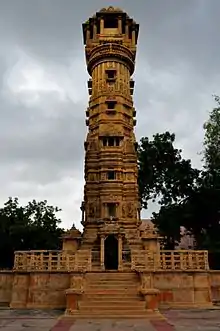Stambha
Stambha (tower in English) is a pillar or column found in India. In the context of Hindu mythology, it is believed to be a cosmic column that functions as a bond, joining heaven (Svarga) and earth (Prithvi). A number of Hindu scriptures, including the Atharva Veda, feature references to Stambhas. In the Atharva Veda, a celestial stambha has been described as an infinite scaffold, which supports the cosmos and material creation.

Kirti Stambha at Chittorgarh fort in Rajasthan, India
| Part of a series on |
| Hindu mythology |
|---|
 |
| Sources |
| Cosmology |
| Deities |
| Personalities of the Epics |
| Hinduism Portal |
| Part of a series on |
| Jainism |
|---|
 |
|
|
A Stambha was and is also used in the context of Indian architecture. Different Stambhas serve different purposes, including the following:
- Dhvaja Stambha (Flagstaff Towers) are placed opposite the main shrine, on an axis with the main deity.
- Kirti Stambha (Glorious Tower) & Vijaya Stambha (Victory Tower) are erected to commemorate victories.
- The most well-known stambhas of India are the Ashoka Stambha (Pillars of Ashoka) — erected during the reign of Ashoka, spread across the subcontinent, bearing different types of royal edicts.
- Adi Purana — a huge manastambha — stands in front of the samavasarana of the tirthankaras, which causes entrants to a samavasarana to shed their pride.[1]
Gallery

 Kirti Stambh of Hutheesing Jain Temple
Kirti Stambh of Hutheesing Jain Temple
See also
- Related topics
- Other similar topics
References
- Shah, Umakant Premanand (1987), Jaina-rūpa-maṇḍana: Jaina iconography, Abhinav Publications, ISBN 81-7017-208-X
- Dictionary of Hindu Lore and Legend (ISBN 0-500-51088-1) by Anna Dallapiccola.
This article is issued from Wikipedia. The text is licensed under Creative Commons - Attribution - Sharealike. Additional terms may apply for the media files.